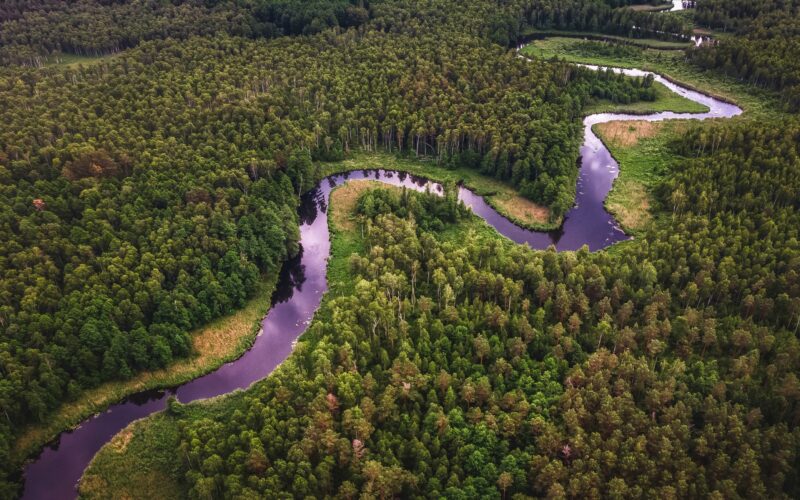You’ve probably already come across businesses and products touting their “net-zero” or “carbon-neutral” impacts. But what does that even mean? And does it even mean anything? Are these companies just paying for someone else to be eco-friendly? Or are they the key to unlocking a sustainable future? Join us as we break down carbon offsets, from the basics of how they work to whether they’re really pulling their weight in the fight against climate change.
What Are Carbon Offsets?
In a nutshell, carbon offsets are when one carbon emitting company (or country) pays another company to pollute less. And essentially “offsets” their own carbon emissions.
For example, an oil company could pay another company to plant trees somewhere in the world to seemingly “cancel out” the amount of carbon emissions they contribute to the planet.
Offsets are generally calculated as a tonne of CO2-equivalent (tCO2e) and mostly involve “emissions reductions” rather than “emissions removal”.
The History of Carbon Offsetting
Carbon offsetting started around 50 years ago now and has seen its fair share of criticism over the years. The idea of emissions offsets for oil, gas and steel industries began in the 1970s when the US Environmental Protection Agency (EPA) created an emissions trading system in response to states struggling to meet their deadlines for national air quality standards.
In the 1980’s the EPA rolled out lead credits to help phase out lead in gasoline, ending the credit program by 1988.
By 1989, the first-ever land-based carbon offset project was established in Guatemala. Applied Energy Services (AES) partnering with CARE, funded an agroforestry project to plant 52m trees to counteract greenhouse gas emissions.
In 1997 the Kyoto Protocol ushered in a new wave of offsets schemes like the Clean Development Mechanism (CDM). This allowed developed nations to meet emissions targets by buying credits from low-carbon projects in developing countries. Although the CDM had some success, one study found that it might have actually increased emissions by 6bn tonnes of CO2.
Two years later in 1999 companies like BP, Mitsubishi, and KPMG formed the International Emissions Trading Association (IETA). In 2000, they published the first voluntary carbon-market standards to help other companies show their corporate responsibility through emission offsets.
But by 2007, carbon offsetting was taking a hit with the public seeing the first widely publicised protests over the practice, calling it a “red herring”.
In 2015, the Paris Agreement introduced Article 6, covering “voluntary cooperation” to help countries meet their climate goals. And in 2022, a call for “zero tolerance for net-zero greenwashing” was made. After years of misuse, this call warned against buying cheap, low-integrity credits instead of making immediate emissions cuts.
Why Do Carbon Offsets Exist?
Carbon offsets started in the United States as a way to make it easier for companies to reach their air quality standard goals. But it did this by giving them a finance out, rather than encouraging them to improve their business practices. Fast forward fifty years and they’re still being used globally in a pretty similar way.
The idea of carbon offsets could work if they were only purchased after a company, or country, has already reduced their emissions as much as possible. Then offsets could help pay for mechanical or natural ways of cancelling out their remaining emissions, the ones they absolutely can’t avoid.
If managed carefully, this could help fund climate action and support developing nations.
How Effective Are Carbon Offsets?
Unfortunately, not very. With multiple accusations of greenwashing and studies showing only 12% of offsets result in real emissions reductions, it doesn’t look great for these programs.
But that doesn’t stop more than half of the world’s largest 100 companies from purchasing offsets – oil, gas and airlines being the biggest buyers. A lot of these offsets are bought from the voluntary offset market, which is basically the “wild west” of regulation and full of “junk” credits. In fact, more than 90% of rainforest carbon offsets are considered worthless.
Violations Against Human Rights and Indigenous People
On top of being pretty ineffective at removing or cancelling out emissions, offsets have also come under fire for displacing Indigenous people and forcing them from their lands. “Carbon pirates” have become an issue in the Amazon region where western companies are trying to buy land for offsetting projects. In Peru’s largest carbon deal, the Kichwa community claims they’ve been pushed off their land in Cordillera Azul National Park and received nothing from the $87 million agreement. And in Guatemala a dam planned under the CDM, issuing credits for developed countries, was connected to the deaths of six Indigenous peoples, including two children.
Overestimating Their Ability To Cancel Out Emissions
Another major criticism of offsets comes from overestimating their ability to remove or reduce emissions. Offsets rely on one company polluting less to cancel out another company’s business as usual emissions. If the less polluting company overestimates their reductions we end up with a net gain overall. Meaning we’re actually making the problem worse, not better.
And it’s pretty easy to get it wrong, both in terms of emissions removal and impact, especially when you’re looking at two very different types of carbon sources. For example, an oil company is drilling into a stable carbon pool of fossil fuels trapped under the earth. Cancelling that out with an unstable pool of carbon in forestry isn’t the same thing. Not to mention short term thinking when we look at how trees will fare in the future with rising temperatures and increasing droughts.
How Carbon Offsets Can Be Improved
Carbon offsets are clearly falling short, but can we turn it around? Is there a way to make them work? Supporters say yes, with a few key strategies.
Increased Transparency
Firstly, transparency and accountability are key. Establishing clear standards and regulations for carbon offset projects, along with robust monitoring and reporting mechanisms, can help ensure projects deliver genuine emissions reductions and adhere to ethical and environmental standards.
The Core Carbon Principles (CCPs) were launched in March 2023 to set a global benchmark for high-integrity projects. The CPP has ten fundamental principles designed to “create real, verifiable climate impact, based on the latest science and best practice”. They cover governance, emissions impact and sustainable development.
Investing In High Quality Projects
If we’re going to invest in offsetting at all, investing in high-quality offset projects is essential. Prioritizing projects with co-benefits, such as biodiversity conservation, sustainable livelihoods, and community development, can help maximize the positive impact of carbon offsetting beyond just emissions reductions alone.
Safeguarding Indigenous Peoples Rights
Carbon offsets projects have been notoriously bad for Indigenous Peoples to date, either by forcing them off their lands or cutting them out of any economic benefits linked to offsets. But land held by Indigenous Peoples is generally stewarded more responsibly and they can reduce deforestation rates more effectively.
If carbon offsets are going to work going forward, Indigenous communities and local stakeholders need to be involved in decision-making processes and should receive fair compensation for their participation in carbon offset projects.
Integrating With Other Strategies
Finally, carbon offset programs are just tools for combating climate change, they aren’t the full answer. While they can play a role in reducing emissions, they shouldn’t be seen as a substitute for efforts to decarbonize and transition to renewable energy sources. If used at all, they should be integrated into broader climate mitigation strategies to enhance their effectiveness.
The information provided in this article is for general informational purposes only. It does not constitute professional advice. The effectiveness of carbon offset programs may vary depending on various factors, and readers are encouraged to conduct further research or seek expert guidance before making decisions related to carbon offsetting.








